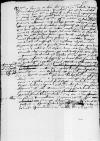Paulo ante, hoc est prima die huius mensis, hinc Dominationi Vestrae Reverendissimae de rebus meis copiose ⌊⌋, totaque mea spes, quantum homini in hominem licet, in benevolentia et favore Dominationis Vestrae Reverendissimae nititur, et cf. Pl. Mos. 350 occidit spes nostra, nusquam stabulum est confidentiae ⌊stabulum bonae superinscribed⌈bonaebonae superinscribed⌉ confidentiaecf. Pl. Mos. 350 occidit spes nostra, nusquam stabulum est confidentiae ⌋collocavit. Neque ambigo, quin Dominatio Vestra Reverendissima omnia ea effecerit, quae mihi commodare necessariaque esse existimabat. Quae hinc alia scribam, non habeo, maxime, cum bonus frater meus ⌊dominus Nibschicz⌋ ⌊⌋, secum feret. Quem tandem molestissime hic moram ferentem written over s⌈stemtem written over s⌉, quantum fieri potuit in mandatis regiis contentum, cum responso ⌊domini consiliarii⌋ absolverunt. Rogaruntque ab eo, ut quaedam secreto ei communicata, quae tum in rem ⌊serenissimae maiestatis regiae⌋ et ⌊Regni⌋, tum etiam ⌊harum terrarum⌋ commoda atque necessaria esse arbitrati sunt, Dominationi Vestrae Reverendissimae in primis, et deinde cum consilio Dominationis Vestrae Reverendissimae ⌊serenissimae maiestati regiae⌋ referret, dedissentque ei litteras fidem facientes, si habuissent sigillum, quod ⌊magistratus Elbingensis⌋ ex officio apud se conservat. Nuntios suos cum sigillo huc misissent, qui adhuc expectantur on the margin in place of crossed-out cuius nuncii qui ad conuentum sigillum Prussiae ferre solent nondum venerant⌈cuius nuncii qui ad conuentum sigillum ⌊Prussiae⌋ ferre solent nondum venerante hidden by binding⌈[e]e hidden by binding⌉x officio apud s hidden by binding⌈[s]s hidden by binding⌉e conservat[1]. Nuntios s hidden by binding⌈[s]s hidden by binding⌉uos cum sigillo h hidden by binding⌈[h]h hidden by binding⌉uc misisse(n)t(?), q(ui) a hidden by binding⌈[a]a hidden by binding⌉dhuc expectanturex officio apud se conservat. Nuntios suos cum sigillo huc misissent, qui adhuc expectantur on the margin in place of crossed-out cuius nuncii qui ad conuentum sigillum Prussiae ferre solent nondum venerant⌉. Mittent tamen eiusmodi litteras paulo post[2]. Rogaruntque me ⌊domini consiliarii⌋ ut, quantum possem impensius, Dominationem Vestram Reverendissimam orarem, ut superinscribed⌈utut superinscribed⌉ ipsi ⌊domino Nibschicz⌋ in iis, quae illorum nomine ⌊serenissimae maiestati regiae⌋ exponet, adesse, desideriis eorum et consilio, quod fidelissime in notitiam ⌊serenissimae maiestatis regiae⌋ deduci cupiunt, adminiculum suum praestare dignetur. Quod illi unamecum omni gratitudine et servitiis suis promereri studebunt erga Dominationem Vestram Reverendissimam studebunt sedulo. Cui ea in re me et illos on the margin in place of crossed-out se mecum(?)⌈se mecum(?)me et illosme et illos on the margin in place of crossed-out se mecum(?)⌉ in summam benevolentiam et gratiam Dominationis Vestrae Reverendissimae commendatum oia(?) summopere diligentissimeque commendo. Dominus Deus eandem Dominationem Vestram Reverendissimam quam diutissime sospitet {ac} superinscribed⌈sospitet {ac}sospitet {ac} superinscribed⌉ prosperetque(?) in omnibus.

 BCz, 244, p. 271
BCz, 244, p. 271